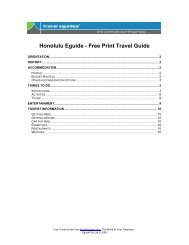Australia Eguide - Travel Guides
Australia Eguide - Travel Guides
Australia Eguide - Travel Guides
Create successful ePaper yourself
Turn your PDF publications into a flip-book with our unique Google optimized e-Paper software.
31<br />
<strong>Australia</strong>n Capital Territory<br />
The <strong>Australia</strong>n Capital Territory came into being on 1st January 1911 and was, as the<br />
name suggests, the area reserved for the new national capital. The Commonwealth of<br />
<strong>Australia</strong> had been formed on 1st January 1901 and since then Melbourne had played the<br />
role of temporary capital. Now a new capital was to be built on this land given by New<br />
South Wales for that purpose.<br />
The <strong>Australia</strong>n Capital Territory comes under the direct jurisdiction of the<br />
Commonwealth (Federal) Government of <strong>Australia</strong>. Administratively, therefore, it is<br />
independent. Geographically, though, it is completely surrounded by New South Wales,<br />
on which state it tends to rely for some of its services. The rail service, for example, is<br />
provided by Countrylink.<br />
The <strong>Australia</strong>n Capital Territory occupies an area of 2,360 square kilometres and consists<br />
of Canberra and its suburbs, together with some surrounding countryside. That is all. It<br />
has, therefore, the distinction of being both the smallest and the most densely populated<br />
of the <strong>Australia</strong>n states and territories. It even spills over into New South Wales, for<br />
Queanbeyan is in New South Wales, but the majority of that town’s working population<br />
is employed in Canberra.<br />
Canberra<br />
Canberra has been the capital of <strong>Australia</strong> since parliament moved here in 1927. It is<br />
essentially an artificial city, created because both Sydney and Melbourne aspired to the<br />
position of national capital, so the logical compromise was to build somewhere new<br />
between the two.<br />
The <strong>Australia</strong>n Capital Territory came into being on 1st January 1911, and an<br />
international competition was held for the design of the capital itself. An American from<br />
Chicago, Walter Burley Griffin was declared the winner. Canberra was named on 12th<br />
March 1913 and construction began soon after.<br />
You will soon find that Mr. Burley Griffin was not much of a straight lines man. Many of<br />
the roads in Canberra are circular or semi-circular. He also believed in grand sweeping<br />
avenues and using plenty of space, since it was readily available. This means that it is not<br />
easy to walk from one place to another in Canberra. Be prepared to use buses, or expend<br />
a lot of energy.<br />
Burley Griffin's basic plan remains at the heart of Canberra. He designed a triangle of<br />
avenues linking three circles, Vernon Circle in the commercial heart of the city, Capital<br />
Hill, which is the centre of the nation's government, and Russell, lying to the east. In the<br />
centre of these was to be a lake, with important public buildings to its south, so that the<br />
sun, shining from the north, would strike them and cause them to be reflected in the lake.<br />
Free from <strong>Travel</strong><strong>Eguide</strong>s.com Online <strong>Travel</strong> Information.<br />
©2008 <strong>Eguide</strong> Pty Ltd




